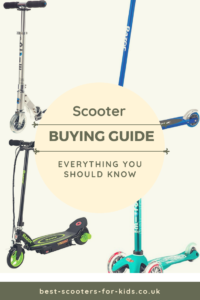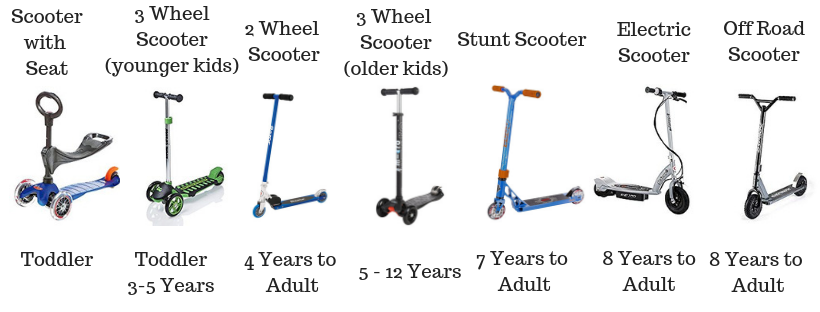Scooter For Kids Buying Guide - Everything You Need To Know When Buying a Scooter for Your Kids
|
|
Looking for a scooter for your child? Confused about all the terms you are seeing - "lean and tilt scooters", "ABEC-5 bearings", "polyurethane wheels". Not sure what how many and what sized wheels to get? 2 or 3 wheel scooter? Well look no further to end all the confusion. This guide will clear up all the confusing terms, language, specifications and decisions you have to make when buying a scooter. Read on for some explanations and a clear head. |
Scooter Type By Age
The first decision you will need to make when choosing a scooter is which is the type of scooter and the best choice for your child's age. Making sure you buy an appropriate scooter for their age is obviously the most important choice to make.
Scooter Type
Choosing the right scooter type is also very important. Here is a run down below:
Scooter with seat - the youngest of riders can get a scooter with a seat so they can start pushing along with their feet before they start scooting. Once they are ready, the seat can be removed and turn into a regular kick scooter.
3 wheel scooter - 3 wheel scooters are great for the younger ride under age 5 as they are sturdier and easy to use. 3 wheel scooters for older riders are also becoming more popular. They tend to have an age range from 5 to 10 or 5 to 12. They are preferred by many older kids and are particularly good for kids who have dyspraxia and other challenges which make riding a 2 wheel scooter more difficult
2 wheel kick scooter - from around age 4 or 5, many children prefer a 2 wheel kick scooter. These are designed from getting from a to b. They aren't designed for doing stunts and tricks at the skate park.
Stunt scooter - stunt scooters are designed to be strong but lightweight. This makes them ideal to withstand the impact from tricks, stunts and jumps but can also be used for commuting from a to b. If you're buying a stunt scooter, start with the stunt scooter guide.
Electric scooter - an electric scooter is powered by a motor and can reach speeds of between 10 and 15mph depending on which on you get. Most will require an manual kick start.
Off road scooter - an off road scooter have pnuematic tyres designed for use on uneven terrain including grass and dirt tracks. They are great for doing stunts on bmx trails.
Scooter Jargon Explained
When reading about scooters online you will see a lot of different terms. Here are some explanations of what it all means...
Wheels
Wheel diameter - Standard wheels on the scooter are generally between 100mm/110mm and tend to be found on standard sized scooters. These are a good size for both cruising on a standard scooter and doing tricks. However, different sized wheels are good for different things.
Larger wheel diameter - (120mm and more) - these tend to be better from cruising from a to b. They will let you cruise faster than smaller wheels. You'll need to push less and you'll glide faster on one push. Bigger wheels tend to offer a smoother ride too. They absorb the shocks from the bumps and cracks on the pavement more easily. Larger wheels are better for cruising on uneven terrain.
Smaller wheel diameter - smaller wheels are better for doing tricks and a manoeuvrable
Wheel material - most scooter wheels are made of polyurethane (PU or urethane). This material offers a smooth ride and is durable. Some cheaper scooter have wheels are made of PVC or plastic - these can be durable but may compromise on the smoothness of the ride. If you are riding an off road scooter, the wheels should have air filled tyres.
Wheel durometer - if you see a measurement for durometer of the wheel it normally ranges from 74A to 88A. The lower the number the softer the wheel and this can be better for shock absorption offering a smoother ride. However, softer wheels tend to wear out faster.
Wheel width - wider wheels can offer more stability. This can be good for younger children.
Have more questions about scooter wheels? Then find out everything else you wanted to know about scooter wheels.
Bearings
Handlebars
Handlebar Steering
Handlebar Height
For comfort and safety aim for a handlebar which is around waist height on your child when they are crusing. If you think about it this makes sense. If you are scooting and the handlbar is too high, the scooter is hard to control. If it's too low you are hunched over which is quite uncomfortable.
Folding Mechanism
Weight of the Scooter
A lightweight scooter is often advantageous to a younger child as it is easier for them to control and manoeuvre. It's also easier for parents to carry and pick up when they're child has decided the no longer want to ride their scooter.
A heavier scooter can mean a stronger scooter. The weight of a scooter will increase as the maximum weight capacity increases. Stunt scooters can be heavier as they need to be strong enough to take the impact of stunts and tricks. However pro stunt scooters have strong materials which are also very lightweight as then they are easier to control when doing tricks but you will pay a premium for this type of scooter.
If the scooter is going to be used for cruising and may need to be carried, look for one which isn't too heavy.
Wheel deck
A wide wheel deck / base will make the scooter sturdier and easy for young kids to balance on. They may be able to fit both feet on the deck when they are cruising. A low to the ground deck is also essential for younger kids. It makes it easier to balance on and safer. It's also easier for very young children to get on and off.
Shorter deck lengths will be better for smaller children so as the deck will not get in the way of their kick path. As kids get taller and older, the length of the deck on the scooters you will be looking at will increase.
Brakes
Foot brakes- most scooters have a foot brake on the rear wheel. Very young children will probably use their feet to slow down the scooter rather that the rear foot brake but as they get older they can be encouraged to use the rear foot brake rather than their shoes.
Hand brakes - some scooters have a hand operated brake in addition to the brake on the rear wheel.
Weight Limit
It's worht paying attention to what the maximum weight limit is on the scooter. If a child is close to the maximum weight limit you may want to get a bigger scooter If there are older siblings or adults that may want to have a go on the scooter, you need to ensure the maximum weight limit will allow them to do it.


